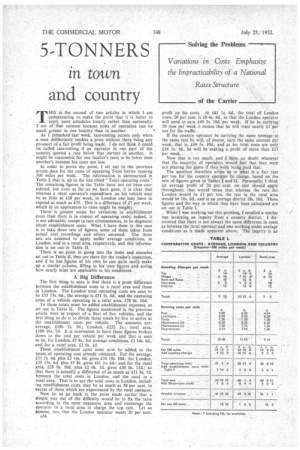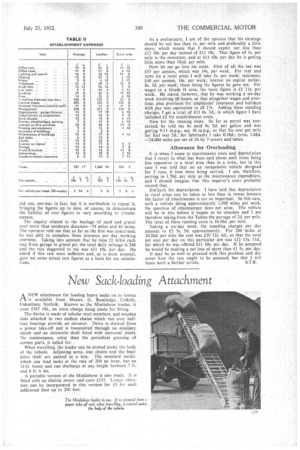5-TON\ERS in town and country
Page 54

Page 57

If you've noticed an error in this article please click here to report it so we can fix it.
THIS is the second of two articles in which I am endeavouring to, make the point that it is better to apply rates schedules locally rather than nationally. Iam of that opinion because costs of operation can be much greater in one Ioeality than in another. • As 1 remarked last • week, rate-cutting occurs only when a man deliberately tenders a price without there being any prospect of a fair profit being made. I do not think it could I be called rate-cutting if an operator in one part of the . country quoted a rate below that current in another. It might be reasonable for one haulier's rates to be lower than . '
another's because his costs are less.
In order to prove my point, I set out in the previous article data for the costs of operating 5-ton lorries running 500 miles per week. The information is summarized in Table I, that is, up to the line titled "Total operating costs." . The remaining figures in the Table have not yet been considered, but even as far as we have gone, it is clear that whereas a raral operator's expenditure on his vehicle may be as little as £28 per week, in London one may have to expend as much as £35. This is a difference of £7 per week, which in its application to rates might be weighty.
There' is greater scope for variations in establishment costs than there is in respect of operating costs; indeed, it is not advisable, except in rare circumstances, to be dogmatic about establishment costs. What I have done in this case is to take three sets of figures, some of them taken from actual cost; recordings and others assumed. The three sets are assumed to apply under average conditions, in London, and in a rural area, respectively, and this information is set out in Table II.
There is no point in going into the items and amounts set out in Table II, they are there for the reader's inspection, and if he has figures of his own he can quite easily make up a similar column, filling in his own figures and seeing how nearly mine are applicable to his conditions.
A Big Difference
The first thing to note is that there is a great difference between the establishment costs in a rural area and those in London. The London total operating costs are seen to be £35 13s. 6d., the average is £31 5s. 44., and the operating costs of a vehicle operating in a rural area, £28 Os. 10d.
To those totals must be added establishment expenses, as set out in Table II. The figures mentioned in the previous, article were in respect of a fleet of five vehicles, and the first thing to do is to divide those totals by five to arrive at the establishment costs per vehicle. The amounts are: average, £186 7s. 5d.; London, £252 2s.; rural area, £100 16s. 7d. .It is convenient to have these figures broken down to the cost per vehicle per week and that is seen to be, for London, £5 8s., for average conditions, £3 14s. 64., and for a rural area, £2 Os. Id.
These establishment costs must now be added to the totals of operating cost already -obtained. For the average, £31 5s. 4d. plus £3 14s. 6d. gives £34 19s. 10d.: for London, £35 13s. 64. plus £5 8s. gives £41 Is. 6d.: and for the rural area £28 Os. 10d. plus £2 Os. Id. gives £30 Os. lid.; so that there is actually a difference of as much as £11 Os. 7d. between the total costs in London, and the total in a rural area. That is to say the total costs in London, includ
• ing establishment costs, may be as muCh as 30 per cent, in excess of those which are experienced by the rural operator. Now let us go back to the point • made earlier that a simple way out of the difficulty would be to fix the rates according to the most expensive area and encourage the operator in a rural area to charge the top rate. Let us assume, too, that the London operator wants 20 per cent. A36 profit on his costs. At £41 is. 6d., the total of London costs, 20 per cent. is £8 4s. 4d., so that the London operator will need to earn £49 5s. 10d. per week. If he be carrying 50 tons per week it means that he will want nearly £1 per ton for his traffic.
If the country operator be carrying the same tonnage at the same rate he will, of course, earn the same amount per week, •that is, £49 5s. 10d., and as his total costs are only £36 li.• 14., he will be making a profit of more than n3
per week.
Now that is too much, and I have no doubt whatever that the majority_ of operators would feel that they were not playing the game if they were being paid that.
The question therefore arises as to what is a fair rate per ton for the country operator to, charge, based on the sets of figures given in Tables I andIL. Personally,•I think an average profit of 20 per cent. on cost should apply throughout; that would mean that whereas the rate for London would be £1 per ton, the rate in the rural area would be 16s. 6d., and in an average district 18s. 10d. These figures and the way in which they have been calculated are set out in Table I.
While! was working out this problem, I recalled a similar one involving an inquiry from a country district. I discovered that there is not always the same difference in costs as between the rural operator and one working under average conditions as is made apparent above. The inquiry is an
old one, pre-war in fact, but it is worthwhile to repeat it, bringing • the figures up to date, of course, to demonstrate the liability of cost figures to vary according to circumstances.
The inquiry related to the haulage Of sand and gravel over more than moderate distances-74 miles and 43 miles. The operator told me that, so far as the first was concerned, he was able to complete three journeys per day working overtime. Taking into account that he runs 12 miles each way from garage to gravel pit, the total daily mileage is 246 and the rate suggested to me was £11 10s. per day. He asked if this rate were sufficient and, as is most unusual, gave me some actual cost figures as a basis for my calculations.
As a preliminary. I am of the opinion that his earnings should be not less than is. per mile and preferably a little more, which means that 1 should expect not less than £12 10s per day instead of £11 10s. That figure of Is. per mile is the minimum, and at £11 10s. per day he is getting little more than 10-id. per mile.
Now let me go into his costs. First of all the tax was 05 per annum, which was 14s per week. For rent and rates (in a rural area) I will take 5s. per week; insurance, £40 per annum, 16s. per week; interest on capital outlay, 8s. 3d. per week; those being the figures he gave me. For wages in a Grade 11 area, the basic figure is £5 1 Is. per week. He stated, however, that he was working a six day week involving 60 hours, so that altogether wages and over time plus provision for employees' insurance and holidays With pay was equivalent to £8' 17s. Adding these standing charges I get a total of £13 Os. 3d., in which figure I have
included £2 for establishment costs. .
Now for the running costs. So far as petrol was "concerned, he told me he paid 4s. 2d, per gallon and was getting 9-11 m.p.g., say 10 mpg so that his cost per mile for fuel was 5d.; for lubricants I take 0.181; tyres, 148d. -24,000 miles per set of 34 by 7 covers and tubes.
Allowance for Overloading It is when I come to maintenance costs and depreciation that I revert to what has been said "about such items being case I WAS told that on an inexpensive vehicle designed less expensive in a rural area than in a town, but in this
for 5 tons, 6 .tons were being carried. I am, therefore,. putting in 1.700. per mile as the maintenance expenditure, and should imagine that this inquirer's costs probably . exceed that.
Similarlj, for depreciation. I have said that depreciation in rural areas can be taken as less than in towns because the factor of obsolescence is not so important. In this case, with a vehicle doing approximately 1,500 miles per week, the question of obsolescence does not arise. The vehicle will be in bits before it begins to be obsolete and I am therefore taking from the Tables the average of 2d. per mile. The total of these running costs is 10.36d. per mile.
Taking a six-day week, the standing charges per day amount to £2 35. 5d. approximately. For 246 'miles at 10.36d. per mile the cost was £10 12s. 6d., so that the total net cost per day on this particular job was £12 15s. lid., for which he was offered £11 10s. per day. If he accepted he would be making a net loss of more than £1 5s. per day.
It may be as well to proceed with this problem and discover bow the rate ought to be assessed, but that I will
leave until a further article.




















































































